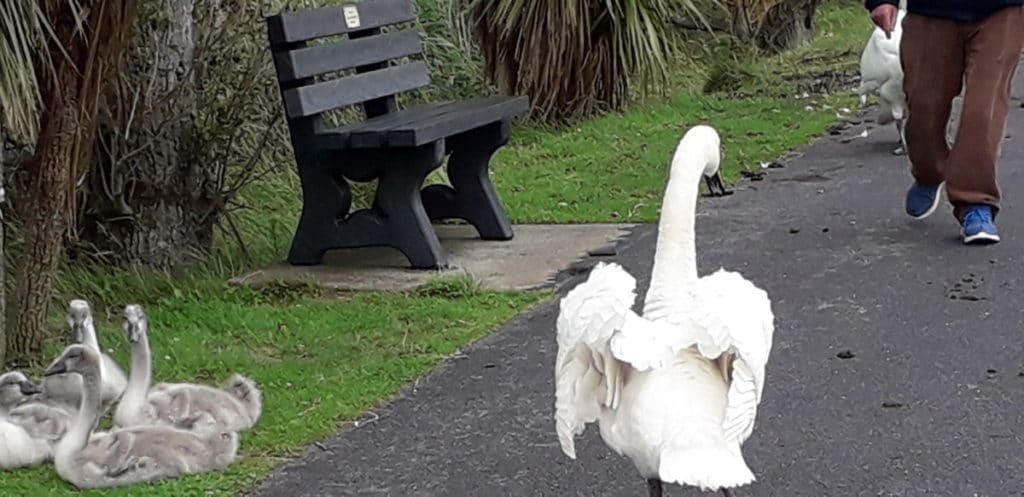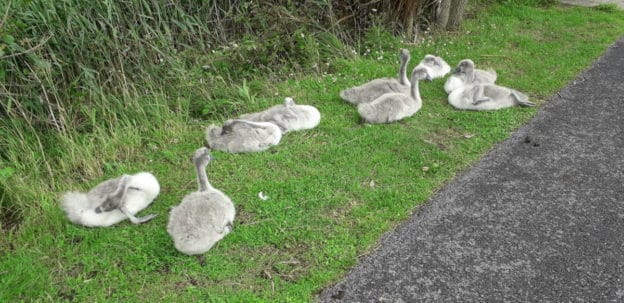The man in a baseball cap is helping people to pass by. His shoulder-length grey hair goes over the collar of his open blue jacket. A woman with two kids on their bikes looks very nervous, a lot more so than her children. One of the kids says ‘they’re really cool’ to no one in particular though I am closest to her on the footpath. The mother is carrying the little brother and his bike, while the man in the baseball cap shields her from the tall male. A few minutes later, while I’m chatting to the man, a woman passes by with her umbrella open and uses it as her shield, though I reckon it’s more of a screen than anything else. I’m only too happy to be finally so close to the Tralee Canal cygnets, all nine of them, and their parents.
“There was eleven of them,” the man in the baseball cap answers when I comment on the nine happy cygnets.
By now we’re close to each other, no doubt far closer than social distancing guidelines and I move a bit along the bank. The man in his eagerness to talk walks after me, maybe he’s hard of hearing but wants to keep the conversation going, so I step down towards the canal and he stops, not wanting to risk the slippery ground.
“I thought I saw more the other day from the road,” I answer, “my daughter took a photo with ten of them in it only last week.”
“Two of them were taken,” he nods, “people say it’s the fox, but I reckon it was mink. The mink don’t care; they kill for the craic.”
All the time while we talk the cob stands watching at us, his long neck looking strong and unbreakable, yet so very elegant. We both agree that the cob is impressive looking and would scare anything away but obviously not a mink. The man comments on how he wouldn’t like to get a slap off one of his wings while I agree, but say that his beak looks frightening too. I’m reassured that his teeth are tiny and the mouth is really only for eating and hissing at potential threats. The man has a lovely interest in the swans, and we both say how we could stand and watch the cygnets all day.
“Your man gets fierce quare,” the man says, nodding at the cob, “especially with dogs, but you couldn’t blame him.”

The family have two nests in the small lake on the other side of the towpath, he tells me. They use one at night and the other as their day residence, but mainly hang out on the towpath while the parents are teaching the cygnets about life. As we stand chatting people are passing by. Most have a comment or two, and everyone is impressed, bar the woman with the umbrella. Kids are fascinated, and a couple of dog owners carry their mutts and walk down the grass to keep a distance. All the time the cygnets do not move, they do a bit of laundry or stretch their legs and give themselves a scratch. They are the cutest things, and the idea of a cygnet being an ugly duckling doesn’t make any sense when you see one up close.
Further down and beyond the bridge is another small lake, more of a turlough really, and a breeding pair is nesting there too. The man tells me how one day, not too long after this brood’s debut on the towpath, the other pen with her cygnets came swimming up the canal. When they got as far as the new arrivals, the pen turned back. One of the cygnets got out though and walked up the grass bank, and the mother missed his escape. After a while the poor cygnet got distressed and was running around the towpath looking for his family. A woman passing by assumed the lost cygnet was part of the brood from the inner lake and managed to catch it and put it in with the other family. Later that day, my man was out on his daily cygnet-watching walk and counted twelve baby swans swimming around the lake. Wondering where the extra one appeared from, he got talking to a woman, who happened to be the one to put the cygnet in earlier and was now back down checking on the family.
“Well they were back down to eleven the next morning so either yer man went home or the mink got him too,” he tells me.
We go on to talking about how the male will begin to chase the new arrivals off come October. I tell him how it’s due to the cygnets shedding their dark down and growing the white feathers like their parents. Once the cob sees the white birds, something in him tells that it is time chase them away.
“He’s vicious about it too,” the man says, “he’ll chase them up the canal there hissing and flapping his wings, biting at them to fly off. No messing with this lad, but I suppose if he isn’t strict they’ll never leave.”
I agree and love that the man knows so much from observing swans over the years of walking by the canal.
“They’re very interesting,” he says gently, as we watch the family enjoying their morning.
I nod, and we step back to leave a couple pass, a father and daughter I’m guessing. The father stops to say that there was twelve but that three of them must be have died. Us two experts nod and smile at each other, neither of us feeling the need to tell the story of the lost cygnet.
It’s not mine to tell anyway.
